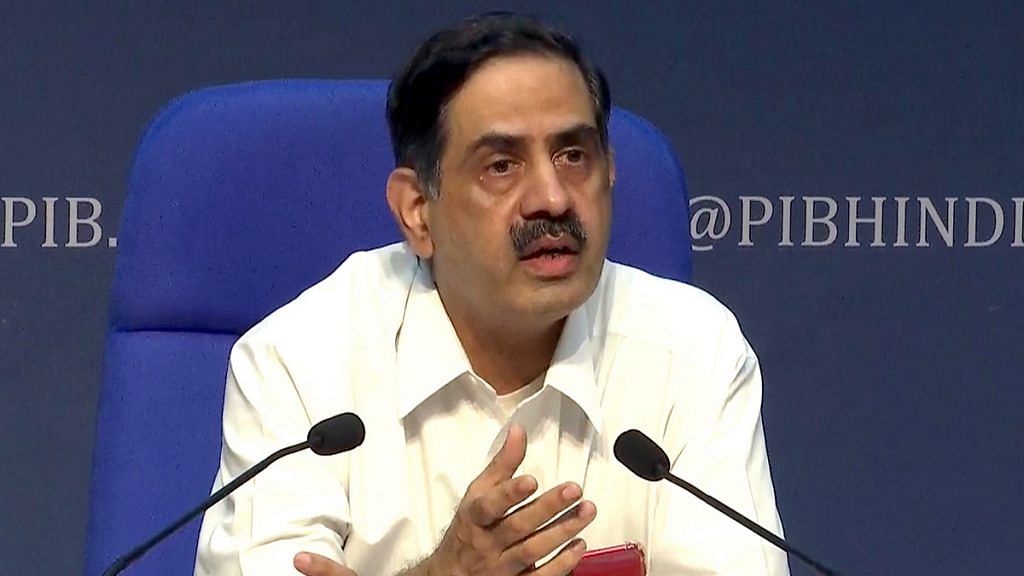New Delhi: Contradicting his own ministry’s guidelines from three months ago, the Indian Council of Medical Research (ICMR) director general Dr Balram Bhargava Tuesday said masks are as effective as vaccines in preventing Covid and should be worn at all times, including while walking or exercising.
“Covid appropriate behaviour and Covid appropriate festivities do not cost anything. It is the most cost effective… The cost of a mask is miniscule. Washing your hands and maintaining distance are cost effective preventive measures,” Dr Bhargava said during his weekly Covid briefing here.
“Regarding masks there is more and more data emerging about masks being protective and preventive and as good as a vaccine. Data also show that masks should be worn during exercise as well. It does not alter blood oxygen levels, so it should be worn while exercising or walking.”
On 3 August, the Ministry of Health had issued a document on ‘Guidelines on Preventive Measures to Contain Spread of Covid-19 in Yoga Institutes & Gymnasiums’.
“Use of face covers/masks is mandatory at all times within the premises,” the guidelines said. “However, during yoga exercise or exercising in gymnasiums, as far as possible only a visor may be used. Use of masks (in particular N-95 masks) during exercise may cause difficulty in breathing.”
There are publications too that have clearly concluded against the use of masks during a workout.
Researchers from the Manipal Academy of Higher Education had in June noted that exercising with masks could aggravate chronic diseases.
“Exercising with facemasks may reduce available oxygen and increase air trapping, preventing substantial carbon dioxide exchange. The hypercapnic hypoxia may potentially increase acidic environment, cardiac overload, anaerobic metabolism and renal overload, which may substantially aggravate the underlying pathology of established chronic diseases,” the researchers wrote.
“Further contrary to the earlier thought, no evidence exists to claim the facemasks during exercise offer additional protection from the droplet transfer of the virus,” they added. “Hence, we recommend social distancing is better than facemasks during exercise and optimal utilisation rather than exploitation of facemasks during exercise.”
There were reports from China early in the pandemic about a jogger’s lung having collapsed because of running in a mask.
In his blog on the Mayo Clinic Health Systems website, sports medicine specialist Jeremy Amundson wrote that considerations have to be made if masks are worn during a workout.
“Yes it’s safe to wear a mask while exercising, but considerations should be made,” he wrote. “For example, it’s recommended that you perform low-to-moderate intensity exercise rather than vigorous exercise while wearing a mask. This is because of the decreased airflow allowed through the mask that can affect breathing and your ability to properly regulate body temperature.”
Also read: ICMR study on BCG vaccine did not assess if it works for Covid, says JNU professor
Delhi, neighbouring states told to continue testing, surveillance
Speaking at the briefing, Dr V.K. Paul, member (health) of Niti Aayog, addressed the rising cases in Delhi and the national capital region (NCR).
Emphasising that the governments of Delhi and its neighbouring states have been told about the need to continue surveillance and testing with “a lot of energy”, Paul said that what is happening in the NCR cities is linked.
“The virus does not respect geographies. This is a big urban conglomerate so what is happening is in a continuum,” Dr Paul said. “There is no need to differentiate. It is the same ecosystem, same environment and same behaviour. It shows that in this conglomerate, the situation is the same everywhere and the virus is still winning. The principles of control are the same — individual behaviour, surveillance, containment, testing strategy and looking after positive cases.”
Replying to a question, Bhargava said there are many hypotheses on why India’s numbers and mortality are better than global averages. These, he said, include the hygiene hypothesis (which says that people living in less hygienic conditions have better immunity), the BCG vaccination programme and the fact that India has a younger population.
Also read: Approved by US, rejected by WHO — science of remdesivir & why it has turned controversial
